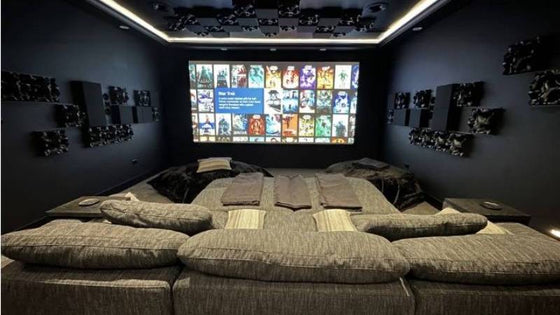Creating a system you love shouldn't be difficult. The Acoustic Frontiers blog is here to help.

Mike L. is a retired aerospace engineer who lives in the Los Angeles area. He built his own home and currently owns and operates a home remodeling business. He has been actively engaged in high performance audio/video since the early 1970s and is an active member of AVS forum.
Mike wanted to build an addition onto his home for a dedicated home theater. He engaged with a number of subject matter experts to make his dream come true, including Acoustic Frontiers for the home theater acoustic treatment design.
The home theater included a number of highly effective but rarely used design elements, including a single bass array (SBA) for the low frequencies, a 3ft absorptive back wall and an all point source speaker array. Electronics included a 16 channel Trinnov Altitude 32.
The SBA concept is a variant on the dual bass array (DBA). The idea is to generate a "plane" wave from the front of the room and then absorb that at the back of the room. In a SBA the absorption is done via acoustic treatment. In a DBA the absorption is done actively by using an identical set of subwoofers to those at the front of the room but run in inverse polarity and digitally delayed so they absorb the bass wave generated by the front subs. The concept is explained in this video:
You can read more about Mike's theater on these AVS Forum threads:
Starting from a 3D CAD model of the room and speaker dispersion characteristics, we planned out a home theater acoustic treatment design that would deliver reference class results.

Acoustic treatment design for the theater ceiling. Additional drawings were provided for all walls.
Our approach to acoustic treatment design is to a) ensure room mode resonances are controlled and b) manage the energy in the early reflected field. See our blog article Early Reflections 101 for more on our approach to this area of home theater acoustics.
In a modern multi-channel home theater, with 8 or more surround speakers, there are many, many reflection points. Each speaker and seat combination will have a primary (first) reflection point on the ceiling, floor, side walls and front/back. The question is therefore how to deal with all these reflections. A lot of these reflections are at high off axis angles, and many involve long reflected path lengths.
Our approach to managing the energy in the early reflected field is based on an understanding of psychoacoustics (how humans perceive sound). We use ray tracing to identify reflection points and consider speaker dispersion and level / delay / direction of reflected sound in our analysis. Reflections from left / center / right speakers are treated differently than reflections from the surround speakers. With the surround speakers we aim to create a uniform acoustic environment such that spatial audio sound effects in Dolby Atmos and DTS.X track seamlessly from a sound localization perspective and do not exhibit timbral change as they move throughout 3D space.

Speaker off axis dispersion data used to calculate acoustic treatments to manage energy in early reflected field
The resulting acoustic treatment design includes a number of custom absorbers with tapered high frequency absorption, as well as checquerboard absorption / diffusion arrays using the Auralex Geofusor in order to create a uniform reflected field for the surround speakers.
The client desired a form follows function home theater acoustic treatment design, and we certainly delivered that!

Reference class acoustic treatment design.

Learn how early home theater design, layout, and acoustic treatment improve performance in new home construction.
This media room was intentionally designed to feel like part of the home—not a separate, tech-heavy space. Through careful acoustic planning, equipment integration, and final calibration, we achieved a room that is both beautiful to live in and immersive to experience.
"No other subwoofer system I’ve owned even comes close to what this room delivers. Reaching out to Acoustic Frontiers was one of the best decisions I’ve made—I highly recommend working with them if you want to get the most out of your theater."

Nyal Mellor, Founder, Acoustic Frontiers



Nyal Mellor
Author